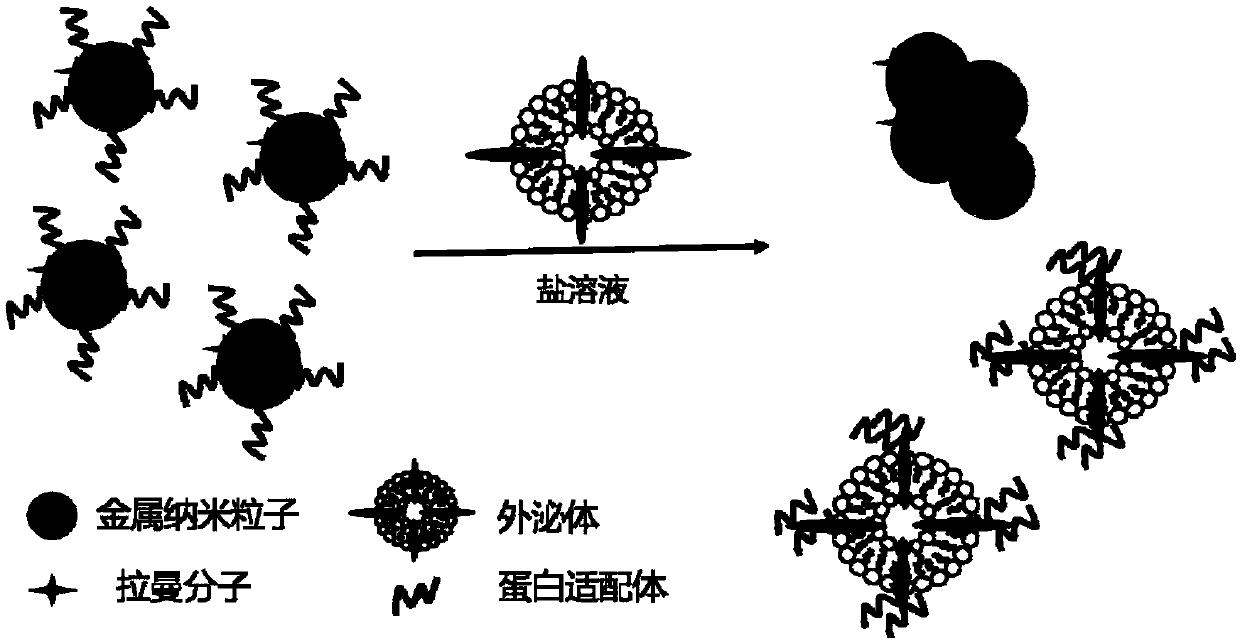Exosome surface protein detection method
A surface protein and detection method technology, applied in the direction of measuring device, color/spectral characteristic measurement, instrument, etc., can solve the problems of high cost, complex detection operation of exosome surface protein, low sensitivity, etc., to improve reliability, fast The effect of highly sensitive exosome surface protein detection and simplified detection steps
- Summary
- Abstract
- Description
- Claims
- Application Information
AI Technical Summary
Problems solved by technology
Method used
Image
Examples
preparation example Construction
[0038] The preparation method of described reporter probe, comprises the steps:
[0039] The first step, adopting sodium citrate reduction method to prepare spherical gold nanoparticles;
[0040] In the second step, Raman molecules are connected on the surface of the spherical gold nanoparticles prepared in the first step.
Embodiment 1
[0042] Using DTNB as the Raman molecule, human breast cancer cell SKBR3 and human cervical cancer cell HeLa as the source of exosomes, the method of the present invention was used to detect the HER2 protein on the surface of the exosomes.
[0043] Step 1, preparing spherical gold nanoparticles:
[0044] Add 200uL of 10% HAuCl in 200mL deionized water 4 solution, stirring vigorously and heating to boiling. Then add 8 mL of 1% sodium citrate aqueous solution, and continue heating and stirring for 15 min. Stop heating, homogeneously stir the solution and cool it down to room temperature to obtain a wine-red spherical gold nanoparticle solution;
[0045] Step 2, connect DTNB to the surface of the spherical gold nanoparticles obtained in step 1 to obtain the reporter probe:
[0046] Take 200 μL of the spherical gold nanoparticle solution in step 1, then add 4 μL of 10 mM DTNB solution, and continue to stir the mixture for 2 hours, then centrifuge and wash twice with distilled wate...
Embodiment 2
[0057] Using DTNB as the Raman molecule and the source of human breast cancer cell SKBR3 exosomes, the quantitative detection experiment of exosome surface proteins was carried out by using the method of the present invention.
[0058] Prepare the reporter probe according to steps 1 and 2 in Example 1, and extract SKBR3 exosomes according to the method described in Step 3 in Example 1. In the detection experiment, add different volumes of SKBR3 exosome solutions, respectively 10 and 40 , 60, 80 μL, the corresponding SKBR3 exosome concentrations are 0.09nM, 0.36nM, 0.54nM, 0.72nM, the blank control group uses PBS solution, the rest of the steps refer to Example 1, and finally observe its color or detect its SERS signal.
[0059] The SERS spectra of the reporter probes obtained in this example reacted with different concentrations of SKBR3 exosomes. With the increase of the concentration of SKBR3 exosomes added, the SERS signal of the reporter probes also increased continuously. ...
PUM
| Property | Measurement | Unit |
|---|---|---|
| size | aaaaa | aaaaa |
| Sensitivity | aaaaa | aaaaa |
| Sensitivity | aaaaa | aaaaa |
Abstract
Description
Claims
Application Information
 Login to View More
Login to View More - R&D
- Intellectual Property
- Life Sciences
- Materials
- Tech Scout
- Unparalleled Data Quality
- Higher Quality Content
- 60% Fewer Hallucinations
Browse by: Latest US Patents, China's latest patents, Technical Efficacy Thesaurus, Application Domain, Technology Topic, Popular Technical Reports.
© 2025 PatSnap. All rights reserved.Legal|Privacy policy|Modern Slavery Act Transparency Statement|Sitemap|About US| Contact US: help@patsnap.com

